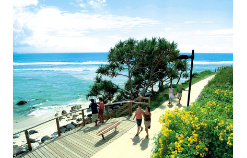Case Studies
Gold Coast Oceanway, Queensland

Overview
The Gold Coast Oceanway provides healthy and sustainable options for pedestrians and cyclists to enjoy Gold Coast beaches. The Oceanway consists of a 36 kilometre network of paved pathways from the Point Danger Lighthouse on the NSW border to the Gold Coast Seaway at the northern end of the Spit.
Key Features
- Provision of connecting pathways between destinations allowing tourists and residents to make more trips via walking and cycling
- Improved access to a wide range of coastal environments including spectacular coastal vistas, headlands, mangroves and dunes and has made them accessible to all people.
Considerations
- By building more generous pathways for pedestrians and cyclists, non-motorised transport useage explodes. There is pent up demand for more sustainable behaviours which can be addressed by investing in this type of infrastructure.
- A focus on intersection detail is critical. People appreciate immensely the ability to walk in a constant alignment and pace without having to step over driveways, service lids, cross streets and bus stops.
- Shade and facilities are critical. People won’t walk in the South East Queensland climate unless there is shade. There also needs to be regular public toilets and playgrounds.
- Location of public artwork can encourage people to utilise pathways by moving artwork and entry statements that once would have faced people in cars, to facing walkways and in “aspirational” locations so that people are challenged to walk to find the art.
Click here for more detailed information on the Gold Coast Oceanway in Queensland.
Last updated on 17th August, 2009
 This project was funded by the Australian Government Department of Health and Ageing.
This project was funded by the Australian Government Department of Health and Ageing.

